Families have a key role in supporting their child’s transition to school but, in practice, transitioning from early childhood education to primary school can often be a disjointed experience for families, with very few opportunities offered for them to communicate their own needs. How can educational settings review and update transition to school practices to develop a more responsive process with families? Recent research has shown the potential of using social media platforms such as Facebook as a digital meeting place to facilitate and initiate a collaborative transition to school[1]. This article examines the research on facilitating a collaboratively constructed transition to school with families and explores the potential use of social media to facilitate this process.
Transition
The transition to school process occurs over a period of time. It begins before children leave their early childhood setting and continues beyond the first day of school until a child develops a sense of belonging in their new setting. This connection with their new setting can vary considerably from child to child[2].Much research about transition to school has focused on families and children and, while they tend to be viewed separately rather than an interdependent unit, the relationship between children and their families is a significant factor in effective transitions. It can be argued that families also experience a transition, as parents and children both need to adapt to new roles. As research usually identifies parents as a child’s main supporters during the transition to school, it is important that teachers provide families with the necessary support to navigate this process.
A family’s transition to school may be viewed as ‘stepping up the ladder’ as well as ‘stepping sideways’ as they negotiate the different routines and procedures which become part of their adjustment to school. A ‘stepping up the ladder’ perspective recognises the move to school as an event that involves a major change for transitioning families[3].This physical move in settings requires families to neogtiate their environment and adapt to structural changes of their day with new routines and procedures.This type of movement can be described as a ‘vertical transition’[4]. A ‘stepping sideways’view of transition, which in its original research context focused on the daily, complicated arrangements for young children’s care amongst working families, can also prompt consideration for the multiple, everyday routine changes involved in transitioning to school[5]. This ‘stepping sideways’ or horizontal transition view serves to remind teachers to consider these many small but meaningful adjustments to the multiple transitions that occur for a child across their school day[6].
What do families want to know?
When families are preparing for their child’s transition to school,they want to have access to a variety of information that will enable them to confidently support their child. Research has identified parent confidence in supporting their child’s transition as an enabling factor for a successful transition to school[7], and studies show the importance of initiating home-school relationships early in the transition process[8]. Families are more likely to feel empowered in supporting their child’s transition when they have access to purposeful and timely information[9]. Studies have highlighted that parents often report receiving too little information too late to enable them to support their child in their transition.
A common theme across the literature is the recognition of the first day of school as a significant event for children and their families[10], although it is important to remember that the transition process does not end as the family enters school on their first day. Families may still need support as they adjust to the new world of school, their new roles as ‘school’ parents and the accompanying expectations. Systems that reassure families that their child is happy and settled in school, provide practical tips such as how to share their child’s reading book, and help parents adjust to their new role of being the parent of a school child contribute to effective transitions[11].Parents in a recent New Zealand study genuinely wanted to know what their child did each day at school. The reassurance that their child was enjoying school was key to parents feeling more secure about their child settling into school[12].
According to research, the physical wellbeing and self-care of a child is an under-explored area of focus in transition interventions. This includes important areas such as toileting, which can impact on a child’s psychological adjustment to their new environment[13]. Teachers can provide parents with supportive information and resources in order to raise their awareness of these considerations in their child’s transition. Families are able to pre-empt these situations and talk through these areas of change in a way that meets their child’s needs[14]. The child can then become more aware of how to manage their self-care and build their confidence in managing their own physical needs[15].
Encouragingly, some countries are increasingly focused on facilitating a collaborative transition to school process in which both families and teachers participate and contribute towards a successful experience for everyone[16].This recognises that parents as well as children undergo the transition to school experience, and consideration is given to supporting the family’s needs as well as the child’s[17].
What role can social media play in facilitating this process?
It takes time to develop relationships and build trust between families and educational settings. By beginning this process through social media and blending this digital meeting space with face-to-face social opportunities, teachers can develop trustful, respectful relationships in a way that can be personalised for each transitioning family as they move from ECE to school. Research shows that a majority of families are engaged with at least one social media platform[18], so using a platform such as Facebook can provide families with a reliable and interactive source of information and enable them to develop their own support network within the group[19]. In effect, the space is hosting and developing a community of practice where a group of people are bonded by the same purpose, and can create material and engage in dialogue to support members’ efforts towards a shared goal[20]. Setting up a closed Facebook page for a group of transitioning families can create a private room as a safe place to facilitate the opportunity for families and teachers to come together and co-construct the transition process[21].
In addition to serving as meeting place, Facebook has a range of tools which can be used to develop innovative and creative ways of collaborating. Here is a list of the useful tools available on the platform and some ideas for their use:
Video and photos provide a way to share transitional resources. Short videos and images that explain school processes and procedures or show aspects of the school day can be shared to support and inform families. Parents’ postings can also provide useful feedback about these resources: for example, parents might respond to how effective a digital story was when they shared it with their child and offer suggestions for further stories. These resources and information are stored and can be further developed while remaining accessible to families to re-engage with when needed.
Videos can be used to share important parts of the children’s routines, which may include lunchtime and after school care. Sharing these with families before the children start school allows parents to discuss these parts of the day with their child. Downloadable resources that can be shared and used at home, such as the playing cards in the screen shot below, may help the child adjust to their new routine.
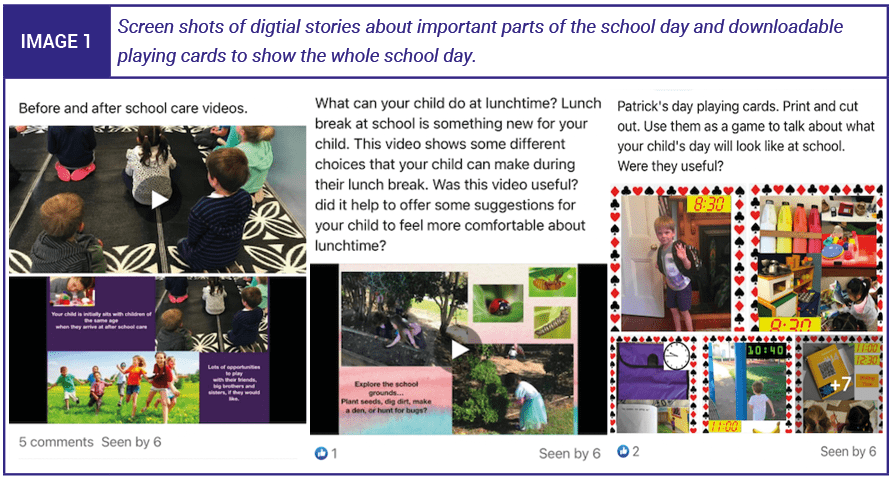
Once the child has started school, sharing aspects of their learning provides families with glimpses of their child’s day at school. Sharing teaching and learning with families can also support them to have conversations with their child.
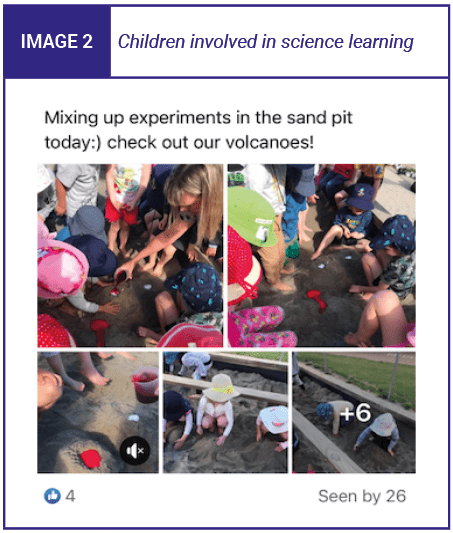
Learning goals focus the child in their learning, and using social media to share how these are set and worked towards can involve families more in their child’s learning. Below is an example of how goals are set in a child’s writing book.
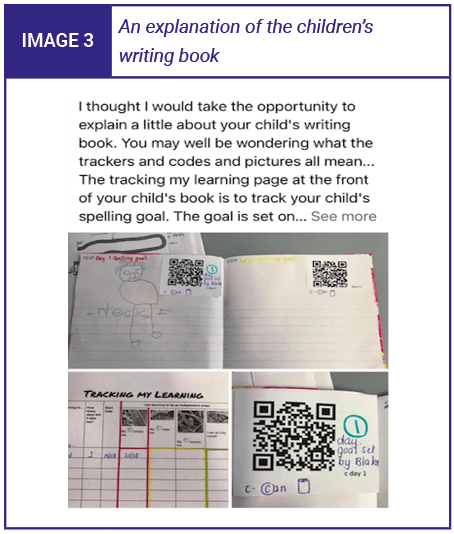
Digital stories can be used to create short scenarios that respond to families’ specific concerns or questions. Teachers can use information from families to create a digital stories that enable families to pre-empt and rehearse new situations with their child and to support their familiarity with managing them. Considerations of day-to-day adjustments that children need to make, such as new toileting routines, can serve as the subject for these digital stories. It is most effective to keep the video short and focused on a single idea, and adding prompt questions helps to provide families with strategies and tools to support discussions at home with their child. Digital stories also have the flexibility to be recorded in different languages so they can be viewed by families in their home language.
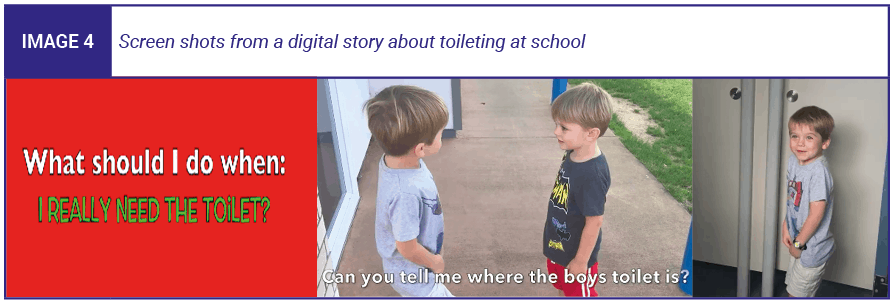
Polling facilities can help to obtain quick responses from families. Polling can be useful for determining if families are finding the transitional resources provided useful, and to gain insight into what is concerning them most about their child’s move to school, allowing teachers to plan their next resource and support. It can also be particularly effective in organising face-to-face events with families as it enables them to negotiate a date and time.
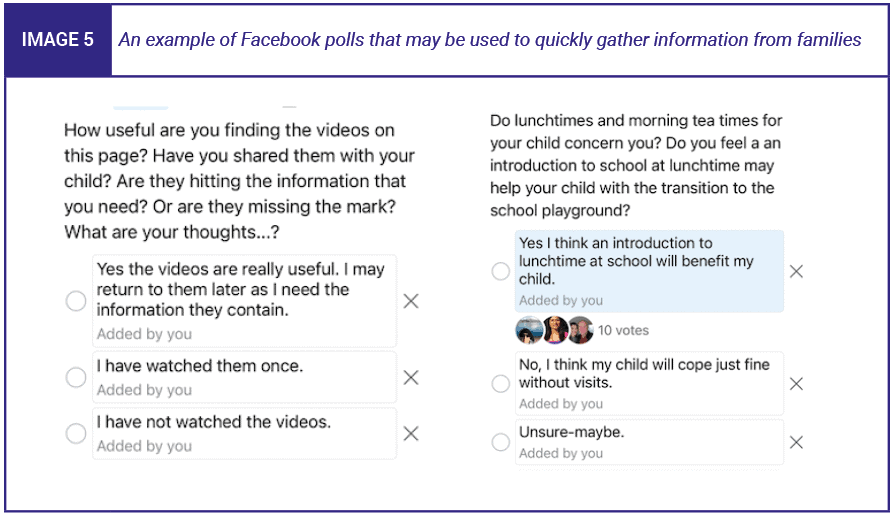
The live feed function allows families to become involved in their child’s learning as it happens. Families often need reassurance that their child is happy and settled in their new environment, and a live feed provides them with direct access. While it is largely used as a tool to share children’s learning with families after they have moved to school, it can also offer a useful glimpse of school to those families who are yet to start school, and can help to familiarise families with the classroom and the kinds of activities that occur during the school day. Posting updates about when this live event is due to be streamed lets families know it is happening and builds the excitement.
When filming for a live feed, setting up a focus activity or offering a roving report of the classroom can provide glimpses into the child’s day. Families are able to react and offer responses in real time which can then be relayed and shared with the children. Those parents who cannot make the real-time session have the opportunity to view the recording at a time that works for them and continue the conversation by contributing their responses to the post.
Social media also offer the flexibility to adapt and respond by monitoring the interest level generated by the material and resources offered to families. Being aware of questions and comments from families can also reveal indications of their changing transitional needs and enables a school or setting to respond with appropriate support or information. Being responsive in this way ensures the Facebook group continues to be fit for purpose as families’ needs change throughout the transition process.
Implications for practice
To develop supportive transition practices that meet the needs of children and families, early childhood settings and schools can:
- Review current transition practices: what works, what does not and why?
- Send families a questionnaire regarding what they want to know about their child’s transition to school. Settings and schools can learn a great deal about their own practices when they see them from a family’s perspective.
- Create a draft transition plan of information and events, using your own professional knowledge and experience alongside suggestions made by families. This plan should not be set in stone but remain open to negotiation as the transition process develops.
- Set up a closed Facebook group. Assure families that this is a safe and secure environment because a closed Facebook group is accessed by invitation only and no material can be shared outside of the group space. Remind families to check their own privacy settings: it is their responsibility to ensure that their profile is set at a level at which they feel comfortable.
- Explore the tools and functions on Facebook, and think creatively and innovatively to develop and share transitional resources and information to families. For example, livefeed can provide a real time invitation to share parts of the school day. Videos, photos and short postings provide a readily accessible way for families to access information they need as they transition to school. Important resources can be ‘pinned’ to the top of the group page to prioritise a posting, ensuring that they are the first item a parent will see on their page.
- Be responsive to families’ transitional needs as they change over time, as this will influence the purpose of your postings and resources. Responding to these changes will help to maintain the group’s engagement.
Endnotes
[1] Woodhouse, H. (2021). Our journey to school: Co-constructing a Community of Practice through a digitally facilitated transition to school. Unpublished doctoral thesis, University of Waikato.
[2] Fabian, H. (2002). Children starting school: A guide to a successful transition and transfers for teachers and assistants. David Fulton.
[3] Brooker, L. (2008). Supporting transitions in the early years. Open University.
[4] Education Scotland, (2020). Realising the ambition: Being me. National practice guidance for early years in Scotland. Scottish Government: Education Scotland.
[5] Brooker, 2008.
[6] Education Scotland, 2020.
[7] De Gioa, K. (2017). Giving voices to families from immigrant and refugee backgrounds during transition to school. In S. Dockett., W. Griebel., & B. Perry. (Eds.), Families and transition to school (pp.37-40). Springer International Publishing.
[8] Dockett, S., & Perry, B. (2007). Transitions to school: Perceptions, expectations, experiences. UNSW Press.
[9] Harper, L.J. (2016). Supporting young children’s transition to school: Recommendations for families. Early Childhood Educational Journal, 44, (653-659).
[10] Woodhouse, 2021.
[11] Hanke, P., Backhaus, J., Bogatz, A., & Dogan, M. (2017). The transition to primary school as a challenge for parents. In S. Dockett., W. Griebel., & P. B. (Eds.), Families and transition to school. Springer International.
[12] Woodhouse, 2021.
[13] Tatlow-Golden, M., O’Farrelly, C., Booth, A., Doyle, O. (2017). “Bursting” to go and other experiences: children’s views on using the toilet in the first school year. The Journal of School Nursing, 33,(3), pp.214-222.
[14] Woodhouse, 2021.
[15] Tatlow-Golden et al., 2017.
[16] Scottish Transitions as a Tool for Change Project Group (2019). Scottish Early Childhood, Children and Families Transitions Position Statement. Glasgow: University of Strathclyde.
[17] Woodhouse, 2021.
[18] Woodhouse, 2021.
[19] Woodley, C., & Meredith, C. (2012). Supporting student transition through social media. American Journal of Distance Education, 26(2), 86-95.
[20] Wenger, E. (1998). Communities of practice: Learning, meaning and identity. Cambridge University Press.
[21] Griebel, W., & Niesel, R. (2006). Co-constructing transition into kindergarten and school by children, parents, and teacher. In H. Fabian. & A.-W. Dunlop. (Eds.), Transitions in the early years: Debating continuity and progression for young children in early education (pp. 64-75). Routledge.
By Hazel Woodhouse

